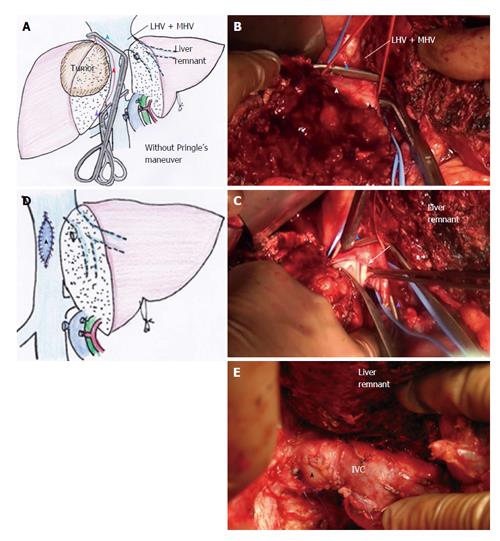Copyright
©The Author(s) 2016.
World J Hepatol. Mar 18, 2016; 8(8): 411-420
Published online Mar 18, 2016. doi: 10.4254/wjh.v8.i8.411
Published online Mar 18, 2016. doi: 10.4254/wjh.v8.i8.411
Figure 4 Oblique cranial cross-clamping, performed in case 4.
A (illustration) and B (intraoperative image): The trunk of LHV + MHV was free from tumor involvement, while the right aspect of the IVC was involved extensively (red arrowhead). After completion of hepatic parenchymal transection, the cranial IVC cross-clamp (blue arrowhead) was applied obliquely between the tumor-involved IVC and the trunk of LHV + MHV preserving outflow of the LHV + MHV trunk, which was possible because the retrocaval space had been dissected sufficiently. Then, the involved IVC wall (white arrowhead in B) and the liver was resected en-bloc under modified THVE; C (intraoperative image): The involved IVC wall was cut away with scissors (arrow) between the oblique cranial (blue arrowhead) and caudal (purple arrowhead) cross-clamps; D (illustration) and E (intraoperative image): The large cut orifice of IVC was reconstructed with IMV patch graft (black arrowhead). See Figure 1D for tumor status. IMV: Inferior mesenteric vein; IVC: Inferior vena cava; LHV: Left hepatic vein; THVE: Total hepatic vascular exclusion.
- Citation: Ko S, Kirihataya Y, Matsumoto Y, Takagi T, Matsusaka M, Mukogawa T, Ishikawa H, Watanabe A. Retrocaval liver lifting maneuver and modifications of total hepatic vascular exclusion for liver tumor resection. World J Hepatol 2016; 8(8): 411-420
- URL: https://www.wjgnet.com/1948-5182/full/v8/i8/411.htm
- DOI: https://dx.doi.org/10.4254/wjh.v8.i8.411









